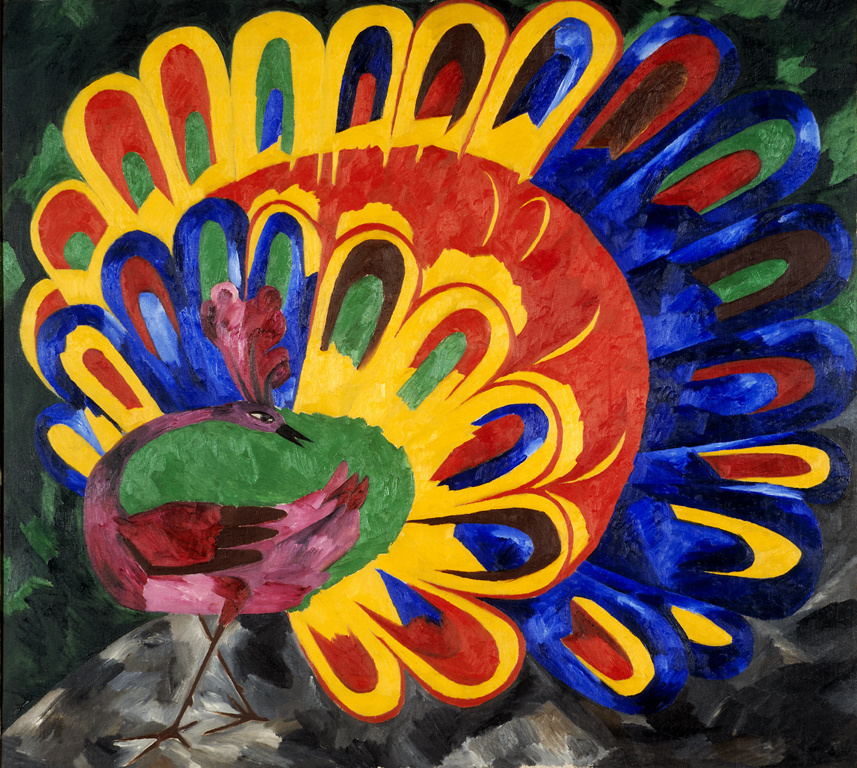log in
Enter site
Login to use Arthive functionality to the maximum
Peacock in the bright sun (Egyptian style)
Natalia Goncharova • Painting, 1911, 144×129 cm
Description of the artwork «Peacock in the bright sun (Egyptian style)»
Passion Natalia Goncharova East is reflected in a series of "Peacocks". She organized the project of "Artistic possibilities about peacock", which depicted a peacock in 10 styles. In the Tretyakov gallery, in addition to "the Egyptian", is stored Peacock (Russian style embroidery)".
Egyptian Peacock written in the style of expressionist primitivism, and this is one of the most temperamental of paintings by Goncharova. For many is "Peacock" became its symbol. The Egyptian version captivates with its colours, lights, the triumph of life. In the film's title is "the sun", but we don't see it, the whole space is occupied the magnificent peacock's tail. Perhaps it is that in all its glory and brightness peacock can manifest when it shines on the sunlight, but it begs another version: he the spread tail in this case, and symbolizes the sun.
A Grand spectacle of colours as embodies the beauty of the world and the act of creation – seems, luxurious tail is happening in the moment when a peacock admiring him. The picture is defiantly two-dimensional, not spatial, that is inherent in Egyptian images. Peacock spread like on the dark gloomy background, which allows more actively to tune up the colors of his feathers.
Natalia Goncharova wrote 'Peacock under bright sun' in the period of revolution to the Russian roots and to the East. Indeed, the style-the Egyptian, the symbols of the East, but does not come to mind when looking at this shining picture of the traditional Russian Firebird folk tales? However, about the passion of the author Gauguin "Peacock" is also reported explicitly (compare, for example).
Goncharov has declared that is disappointed by the West, and henceforth all its interests are directed to the East. Peacock embodies Eastern brightness, the enjoyment of life, heat and passion. It seems, with its sparkling color and light feathers pours inexhaustible life energy, a primordial force, like the immortality embodied in his image. In the East the peacock is indeed a symbol of immortality.
If the doctor prescribed instead of prescription pills tickets to art galleries, late fall and winter, patients would be worth to send to a gallery to look at the picture as a source of visual vitamins, to increase the level of vitality.
Author: Alain Esaulova
Egyptian Peacock written in the style of expressionist primitivism, and this is one of the most temperamental of paintings by Goncharova. For many is "Peacock" became its symbol. The Egyptian version captivates with its colours, lights, the triumph of life. In the film's title is "the sun", but we don't see it, the whole space is occupied the magnificent peacock's tail. Perhaps it is that in all its glory and brightness peacock can manifest when it shines on the sunlight, but it begs another version: he the spread tail in this case, and symbolizes the sun.
A Grand spectacle of colours as embodies the beauty of the world and the act of creation – seems, luxurious tail is happening in the moment when a peacock admiring him. The picture is defiantly two-dimensional, not spatial, that is inherent in Egyptian images. Peacock spread like on the dark gloomy background, which allows more actively to tune up the colors of his feathers.
Natalia Goncharova wrote 'Peacock under bright sun' in the period of revolution to the Russian roots and to the East. Indeed, the style-the Egyptian, the symbols of the East, but does not come to mind when looking at this shining picture of the traditional Russian Firebird folk tales? However, about the passion of the author Gauguin "Peacock" is also reported explicitly (compare, for example).
Goncharov has declared that is disappointed by the West, and henceforth all its interests are directed to the East. Peacock embodies Eastern brightness, the enjoyment of life, heat and passion. It seems, with its sparkling color and light feathers pours inexhaustible life energy, a primordial force, like the immortality embodied in his image. In the East the peacock is indeed a symbol of immortality.
If the doctor prescribed instead of prescription pills tickets to art galleries, late fall and winter, patients would be worth to send to a gallery to look at the picture as a source of visual vitamins, to increase the level of vitality.
Author: Alain Esaulova


